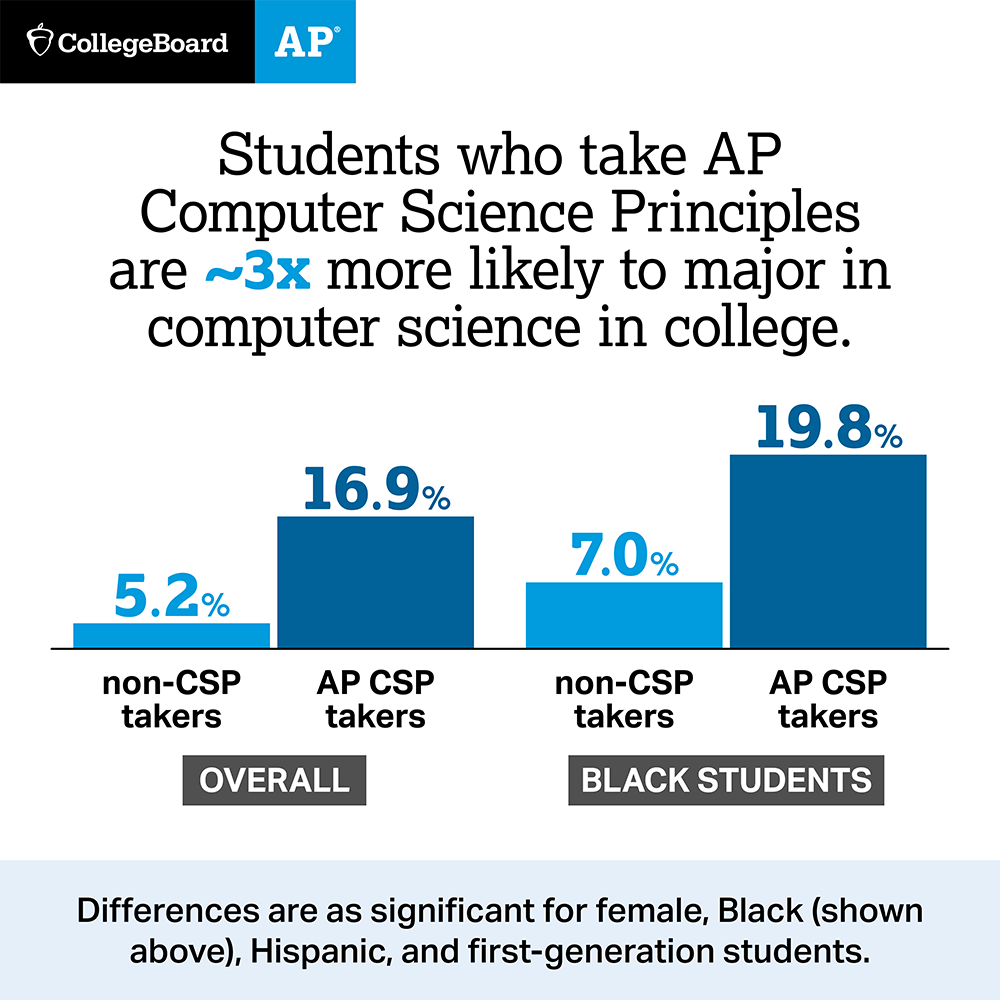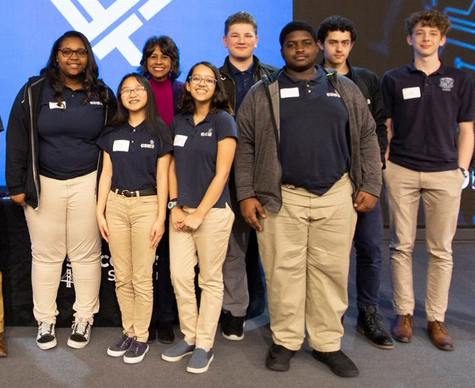12/9/2020
New Data: AP Computer Science Principles Course Bringing More Diverse Set of Students Into Computer Science Pipeline
AP CSP Students—Especially Black, Hispanic, Women, and First-Generation Students—More Likely to Declare STEM, Computer Science Majors in College
New York—New research shows increasing diversity in Advanced Placement (AP) computer science four years after the launch of AP Computer Science Principles (AP CSP). In 2016, College Board, with significant support from the National Science Foundation, launched AP CSP to address a well-documented shortage of women and students of color studying science, technology, engineering, and math (STEM) in high school and college and ultimately pursuing STEM careers. This foundational course was designed to change the invitation to computer science education and engage traditionally underrepresented students.
In new research published today, College Board finds students who take AP CSP in high school are more than 3 times as likely to major in computer science in college, compared to similar students who did not take CSP. Differences are similarly large for female, Black, Hispanic, and first-generation college students. College freshmen who declare a computer science major take a critical step toward receiving the second highest paid college degree in the nation, according to the National Association of Colleges and Employers.

The study also finds AP CSP students are nearly twice as likely to enroll in AP Computer Science A (AP CSA)—a course more focused on computer programming—compared to similar students who did not take CSP. Notably, gaps in AP CSA enrollment by race/ethnicity are greatly reduced. Black students who take AP CSP are three times more likely to take AP CSA, virtually the same share as Asian CSP students, who have long led AP CSA participation.
A third finding suggests that AP CSP serves as a stepping-stone to other advanced AP STEM coursework for most AP CSP students. For the class of 2019, AP CSP was the first AP STEM course for more than half of CSP students, and more so for Black students (68%), Hispanic students (59%), and first-generation students (60%).
"Four years ago, we set out to change the invitation to computer science education," says College Board Chief of Global Policy and External Relations Stefanie Sanford. "This new research provides compelling evidence that AP CSP is doing exactly that. We are inspired to see how this course is playing a role in students' high school and college careers just four years after its launch. States, schools, and educators providing access to AP CSP are ensuring a more representative body of students will become our next generation of computer scientists, engineers, and technology leaders."
"I took a coding class as a sophomore in high school, but I didn't really enjoy it because I didn't understand it," said Jennifer Sandford, a college freshman from St. Louis, Missouri, who's now a computer science major at Indiana Tech University. "When my teacher, Mr. Schenk, suggested I take AP Computer Science Principles, I thought, ‘Me? An AP course?’ But right away I loved it. AP CSP shows you how to solve problems, how to analyze problems you care about, and that there isn’t just one path to a resolution."
Jennifer says her favorite part of the class was collaborating as a group, sharing ideas, and being creative with her projects. She had only a few female classmates, which she says helped her decide to explore computer science beyond high school.

Jennifer Sandford (at far left) with her AP CSP classmates from CSMB ’20. Her team presented their project—an app to help students track and find volunteer opportunities in St. Louis—at World Wide Technology.
“The turning point for me was when I realized that with so few women in the class, I had an opportunity to stand out. I thought, maybe this is something I should pursue. I’m a first-generation college student and my high school was geared toward medicine, so when my mom found out I wanted to major in computer science, she didn’t understand. Then she saw how it built my confidence and how much I enjoyed it, and she understood this was the best path for me. Now I want to own my own tech company someday."
The first year of AP Computer Science Principles in 2016-17 attracted more students than any other AP course debut, and participation is on the rise. In 2020, more than 116,000 students took the AP CSP Exam—more than double the number of exam takers in the course’s first year, and a 21% increase over the previous year. In 2020, 39,570 women took the AP CSP exam, nearly three times the number who tested in 2017.
Here are just a few reasons why computer science education is more important than ever:
- In 2019, demand for computer science graduates continued to outpace supply. There were more than 389,000 computing job openings but fewer than 72,000 computer science graduates to fill them.
- The median annual wage for computer and information technology occupations was $88,240 in May 2019.
- A code.org analysis of 2017 Bureau of Labor Statistics data finds women represent just 24% of the 5 million people in computing occupations, while 15% are Black or Hispanic.
Currently, less than half of the nation’s high schools teach foundational computer science. States are working to broaden participation in computer science by passing policies to make computer science a fundamental part of the K–12 education system. Over the past year, 28 states passed 42 new laws and regulations promoting computer science.
What Others Are Saying About AP Computer Science Principles
"At Amazon, we know a high-quality computer science education is key to helping students build their best and brightest future, especially those from underserved and underrepresented communities," said Shanika Hope, Head, Amazon Future Engineer, U.S. "We're excited that today’s research shows further evidence that courses like AP CSP—which we provide for thousands of our Amazon Future Engineer schools across the U.S.—are preparing a more diverse group of students to enter the 21st century workforce."
"We are proud to work with schools and teachers to help expand access to the AP Computer Science Principles course through our Technology Education and Literacy in Schools (TEALS) program. Computer science education for high school students helps them to successfully prepare to compete in the digital economy. This important course is providing young people with the opportunity to learn the fundamentals of computing, including problem-solving, big data, the internet, and cybersecurity. It is exciting to see that exposure to these timely topics in high school is helping to diversify the computer science pipeline," said Fred Humphries, Corporate Vice President of U.S. Government Affairs, Microsoft.
"Aligning what's taught in the classroom with the skills necessary to grow the workforce of tomorrow is one of our top priorities," said Cheryl Oldham, Vice President of Education Policy at the U.S. Chamber of Commerce. "Today's research demonstrating the impact AP Computer Science Principles is having on students is exactly the kind of progress we need to see in American education. Jobs and skills are changing faster than we can communicate. We applaud the work of educators and students who recognize a computer science education is a critical step toward a competitive career, and an innovative and inclusive economy."
"Across the country, we know that structural barriers in access and exposure to computer science education and rigorous coursework in science, technology, engineering, and mathematics (STEM) create disparities in opportunities to learn particularly for young girls, students of color, and students who would be the first in their families to attend college," said former U.S. Secretary of Education and CEO of The Education Trust, John King, Jr. "I am encouraged to see that the College Board’s new Advanced Placement Computer Science Principles course is helping to address these disparities by offering historically underrepresented students the chance to participate in rich, engaging STEM learning that can open the door to new knowledge, postsecondary study, and career pathways. We need additional efforts like this throughout the nation to expand computer science learning to more students."
"The AP CSP story is a story of systems-level change that is sustainable and far reaching. AP courses are a key part of the college preparatory process, so it makes sense that if we want CS graduates, increasing access to AP CS is key," said Ruthe Farmer, Chief Evangelist, CSforALL. "We're thrilled to see the growth in participation, especially among girls and underrepresented groups, and pledge to continue our work to support the CS education community broadly in building equitable K-12 CS pathways that will ensure all students are informed and prepared for higher level courses like AP CS."
"PLTW's mission is to provide a transformational learning experience using a personalized and relevant problem-solving approach that supports and unlocks the potential in all students and teachers," said David Greer, Project Lead The Way (PLTW) Executive Vice President and Chief Programs Officer. "We are excited to see that PLTW and AP CSP are engaging and empowering those who have been historically underserved in our nation."
"It's great to see that AP CSP is helping more students create a path towards a computer science major, which is more essential now than ever," said Jeremy Keeshin, CEO of CodeHS. "Our team at CodeHS has been glad to partner with teachers and schools to help support this mission to make computer science more equitable."
"The AP Computer Science Principles course is vital to making computer science inclusive to all students," said Allyson Kennedy, Program Director in the Directorate for Computer and Information Science and Engineering at the National Science Foundation. "NSF is proud to have collaborated with the College Board since the inception of the AP-CSP framework and continues to support efforts that provide young women, students of color, and students with disabilities across the nation with the opportunity to pursue computing degrees and careers."
"We're so excited to see AP CSP students choosing to pursue computer science in college," said June Mark, Principal Investigator at The Beauty and Joy of Computing (BJC). "It is critical that young women and students of color see themselves as future computer scientists, software engineers, mathematicians, and scientists. The BJC team is pleased to partner with the College Board to continue to expand computer science opportunities for girls, Black, and Latinx students, and to improve and diversify student retention in CS and other STEM fields."
"AP CSP is successfully expanding participation in computer science by underrepresented groups," said Hadi Partovi, Founder and CEO of Code.org, provider of the most widely used AP CSP curriculum. "That is at the heart of our mission, and it’s incredibly encouraging to see the long-term impact the education community can make on students and the doors that open for them when we focus on equity."
"UTeach Computer Science started with a handful of passionate advocates for CS education at the University of Texas at Austin. Over the last 5 years, we've provided training and support to more than 2,300 high school teachers—many of whom had no prior experience teaching CS—to reach thousands of CS students across 43 states and 8 countries. We are thrilled to see how AP CS Principles has introduced so many new teachers to computing and increased access to CS for students around the world."
About AP Computer Science Principles
AP Computer Science Principles is an introductory college-level computing course that welcomes students into the field of computer science through hands-on, project-based, collaborative learning. Students explore the big ideas of computer science and internet concepts that power the world around them. AP CSP educators have the flexibility to choose the programming language for their course, unlike Computer Science A, where students focus on problem solving and computing skills related to programming in Java.